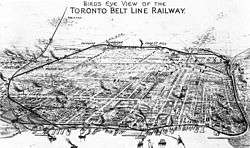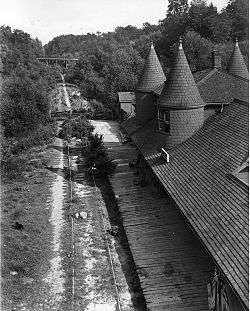Toronto Belt Line Railway
 | |
|
The Moore Park station in 1909 | |
| Locale | Toronto, Ontario, Canada |
|---|---|
| Dates of operation | 1892–1894 |
| Track gauge | 4 ft 8 1⁄2 in (1,435 mm) standard gauge |
| Headquarters | Toronto, Ontario, Canada |
The Toronto Belt Line Railway was built in Toronto, Ontario, Canada in the 1890s. It was constructed as a commuter railway line to service and promote new suburban neighbourhoods north of the city limits. It ran in a loop to Union Station through the communities that eventually became Rosedale, Moore Park, Forest Hill and Swansea. The line was never profitable and it only ran for two years. Today, as part of a rails-to-trail project, the remaining part of the line is now the Beltline Trail.
History
The railway was built by railway entrepreneur James David Edgar, a politician and railway financier. The railway was necessary because many of the current bridges did not exist at time, and access to areas like Moore Park was very difficult, requiring repeated trips up and down steep ravine roads. Belt Line Railway brochures[1] used 'Spring Valley' instead of 'Mud Creek' as the name for what is now Moore Park Ravine.
As a result of a booming real estate market in the late 1880’s, the Toronto Belt Line Company planned to develop land in the suburbs. Thus, it built the commuter railway to connect these new suburban areas to the city.[2]
Passenger service first began on July 30, 1892, ran for 870 days before it ceased on November 17, 1894. The railway never made a profit.[3] There were a number of reasons for this - the fare prices were too high at the time (25 cents between any two stations) and the country was experiencing a financial depression in the 1890s. The drive to develop these new communities was blunted by the depression of 1893, and it took longer to open up the new neighbourhoods than the developers had hoped. Also, electric streetcars of the Toronto Railway Company along with radial railways such as the Metropolitan Street Railway were providing more direct routes to downtown.[2]
Although passenger service ended, the Belt Line Railway Company continued to exist. It was eventually sold on December 31, 1943 to Canadian National Railway (CNR) for $410,000 CAD. Three of the five 4-4-2T commuter tank locomotives specially built for the Belt Line were eventually used on the Thousand Islands Railway in Gananoque, Ontario.[4]
In 1906, the relatively short section in the Don Valley south of Winchester St. (across from Riverdale Park) was used as part of a new line by the CNR connecting Toronto to Parry Sound. The tracks on the steep grade (4%) in the Moore Park Ravine were pulled up during World War I due to a shortage of iron. The remaining spur line running east from Caledonia was used by an occasional freight train, servicing lumber and coal yards along Merton St, and in the 1950s the new TTC subway yard at Davisville at Yonge St. Track on the western loop was pulled up shortly after service ended, and part of the right-of-way was later used by the Toronto Suburban Railway and some other lands were sold off to local developers.
After passenger trains stopped operating, parts of the rail line sat unused for several years. In the late 1960s part of the right-of-way was expropriated to build the Spadina Expressway. This split the remaining spur close to its origin at Caledonia, which was used to service light industry in the Caledonia Road area into the 1990s.
In the 1970s, CNR tried to sell the right-of-way for housing since the land was quite valuable. Most home owners adjacent to the line wished to buy the land to extend their backyards. A local citizen, Esther Carin, successfully lobbied city council to turn the section east of Allen Road into a walking trail. The land was purchased by the city in 1972 as part of a land swap with CN that included the Metro Toronto Convention Centre on Front Street. Later, a trail on the west side of the Allen would be established as well. Today, the Beltline Trail is a 9 km walking and cycling trail.
Routes
The railway consisted of two separate loops both starting and ending at Union Station. The larger Don loop went east to the Don River. It turned north following the river before journeying up a steep grade through the Moore Park Ravine beside the Don Valley Brick Works. It then turned west at the north edge of the Mount Pleasant Cemetery along Merton St. At Yonge Street it turned northwest travelling through Forest Hill until just north of Eglinton Avenue West. There, it turned west again before returning to Union Station via the Canadian Northern Railway (now CNR) line west of Caledonia Road.[3] A complete trip was approximately 40 km (25 mi).
A second, smaller Humber loop headed west along the northwest rail corridor. It turned west just north of St. Clair Avenue and then turned south at Lambton Mills, just east of the Humber River. It ran south following the edge of the Humber River valley. It followed a route paralleled by the South Kingsway just west of High Park. It returned east along Lake Ontario.[3]
Stations
None of the stations built for the line exist today.
- Don Station (relocated to Toronto Railway Heritage Centre).
- Moore Park Station - located south of Moore Avenue[2]
- Forest Hill Station - located west of Bathurst Street[2]
- Fairbank Station - located at Dufferin Street[2]
- Eglinton
- Yonge
Bridges
- Mount Pleasant Road bridge
- Moore Avenue bridge
- Clarence Avenue/Heath Street bridge
- Davisville Avenue bridge
- Winchester Street Bridge
- Dufferin Street bridge
References
- ↑ Local Interest Collection of the Deer Park Library, Toronto
- 1 2 3 4 5 "Beltline Railway". Lost Rivers. Retrieved 2016-10-08.
- 1 2 3 Mike Filey (1993). From horse power to horsepower. Dundurn Press. p. 79. ISBN 1550022008. Retrieved 2016-10-08.
- ↑ Douglas N W, Smith, "By Rail, Road and Water to Gananoque", Pictures: Pages72, 104. Trackside Canada, 1995
- Akler, H., and S.B. Hood. 2003. Toronto, the Unknown City. Arsenal Pulp Press. ISBN 1-55152-146-6
- Central Ravines, Belt Line & Gardens Discovery Walks. Retrieved Jan. 16, 2006.
- Russell, C.H. 1996. Tightening the belt: a history of the Toronto Belt Line Railway. Box 207158, Folio 1. City of Toronto Archives
- Sauriol, Charles. 1981. Remembering the Don: A Rare Record of Earlier Times Within the Don River Valley. Consolidated Amethyst Communications. ISBN 0-920474-22-5
- Sauriol, Charles. 1984. Tales of the Don. Natural Heritage/Natural History. ISBN 0-920474-30-6
External links
- Lostrivers.ca article on Belt Line Railway
- SpacingToronto.ca article on the Belt Line Railway
- Toronto Belt Land Corporation (1891). The Highlands of Toronto. Retrieved July 22, 2012.
- Pamphlet for the Central Ravines, Belt Line and Gardens Discovery Walk
External links
- Shawn Micallef (2015-01-15). "The beltline trail keeps growing". Toronto Star. Archived from the original on 2015-01-19.
Opened in 1892, the railway lasted only two years as the expected residential development in the north of the city didn’t materialize.
